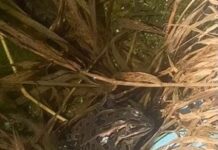by Fred Schueler and Aleta Karstad
Streams, ponds, and lakes support a diverse range of species of snails and bivalves (clams & mussels), with fascinating life histories and diversely beautiful shells which are important elements of aquatic ecosystems. Every two years, the Centre for the Study of Inland Waters in Burlington hosts a Canada-wide meeting on freshwater Molluscs – https://www.cfmrm2023.com/. In the post-meeting message sent by the organizing committee: “…a huge shout out to all our presenters and sponsors …this meeting was by far our largest. It is amazing to see how much the Canadian mollusc community has grown since the first meeting nearly a decade ago. The breadth and scope of research being undertaken by all of you is truly amazing and inspiring!”

North Grenville’s Fragile Inheritance Natural History presented three papers at the meeting, though a threat of illness meant we couldn’t attend in person:
Exploring the Upper St. Lawrence River and its tributaries for Unionid mussels including the Eastern Pondmussel, with Kate Schwartz, Matthew Windle, Emma Ehrenfeld, Elizabeth Hall, Elizabeth Grohmann, and Alisha Ng of the St Lawrence River Institute. Before Zebra Mussels invaded the Great Lakes, the Eastern Pondmussel (Sagittunio nasutus) was one of the most abundant and widespread native mussel species in the Lower Great Lakes, but it was nearly wiped out by fouling by Zebra Mussels. When we found this species in Lyn Creek, west of Brockville in 2005, this was the second known surviving population in Canada. We and others have found a few more remnant populations, but the species lives in slow-moving mucky-bottom sites, and can be hard to find. This summer, we worked with the River Institute to search the Upper St Lawrence and its direct tributaries for this and other native mussel species, using a combined approach of environmental DNA (eDNA) and timed searches. From June to October, 20 sites in tributaries and 40 in the St Lawrence River were sampled for eDNA, and we await the outcome of the analyses of these samples.
Declines in abundance of Cipangopaludina chinensis (Chinese Mystery Snail), with Naomi Langlois-Anderson of South Nation Conservation. Chinese Mystery Snails are remarkable because of their huge size (to 60 mm high), and uniform dark colouration. Introduced to the Pacific Coast for food by oriental immigrants in the 19th Century, and to many places throughout eastern North America as aquarium snails through the 20th century, these are now widespread in Ontario, often as amazingly abundant populations. We reviewed our records, and found that we had observed 7 apparent declines, 4 sites where the population appeared stably common or abundant, 7 sites where they were abundant and 3 where they were sparse at one visit, and 2 sites where they appeared at places we’d previously repeatedly visited. We’ve found them as nearby as Winchester and the Rideau at Carleton University, but haven’t seen any in Grenville County. The declines may be due to control efforts, predation by Mammals, onset of Zebra Mussel populations, or drought. We can’t certainly assign any of the declines to a particular cause, but we will be looking out for evidence through the 2024 field season.
Drawdowns of Doom: Biodiversity impacts of water level management in impoundments. Triggered by observations of frog and snail mortality at the Kemptville Creek dam in Oxford Mills, we’re on a campaign to get recognition of the mortality of aquatic species that lowering water levels behind dams brings about. Drawdowns are nominally done to protect infrastructure and provide reserve capacity to hold back water during spring flooding, but it’s important that their impacts on the life in the impoundments be noticed and studied, so that these can be taken into account when planning water level management.
The meeting had lots of presentations on distribution, sampling methods, toxic threats, and recovery methods, though because the many species of native mussels are the ones with Species-at-Risk funding, there was a heavy emphasis on these species in southwestern Ontario. Offsetting the neglect we saw of some subjects in the meeting will inform our field work for the coming year: hybridization between eastern and western stocks of common mussels in eastern Ontario and western Quebec, the apparent decline in Zebra mussel populations, and annual movements of mussels in stream and lake bottoms. We’re updating our manual of identification of Molluscs and other large aquatic invertebrates, and can send a copy to anyone who is interested.
Fragile Inheritance Natural History bckcdb@istar.ca.








